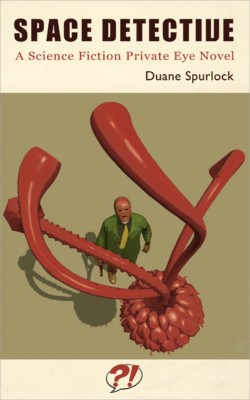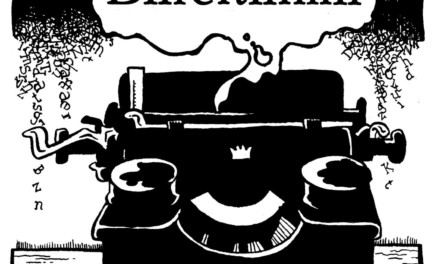 I set up the distribution for Space Detective to avoid limiting access to just Amazon and/or Barnes & Noble, so readers could procure it from their preferred online dealer, whether for a paperback or ebook edition. Even libraries and retail brick-and-mortar stores can order and put this book on their shelves.
I set up the distribution for Space Detective to avoid limiting access to just Amazon and/or Barnes & Noble, so readers could procure it from their preferred online dealer, whether for a paperback or ebook edition. Even libraries and retail brick-and-mortar stores can order and put this book on their shelves.
However, the teaser preview that online retailers provide differs according to the site you visit. Amazon appears to offer the longest preview. Other retailers, none at all.
So I’m posting an extended excerpt so everyone can have a look, no matter where you choose to shop. Here we go:
CHAPTER ONE
Despite the Model 6’s well-documented flaws, the Space Detective preferred the Model 6 Rigelian Hand Zapper to the Model 8. He found it a better-balanced blaster that fit his hand just so. The Model 8 felt barrel-heavy to him. And the way the 8 molded itself to his hand was very unsatisfying—and a little disturbing. (More than once I heard him say, “I just don’t know what they were thinking when they started using those Nevian Octo-ambient grips on the Model 8. When I let go of the gun, it wouldn’t let go of me. Had to pry it off my fingers.”)
So the Space Detective radiated absolute confidence as he leveled his Model 6 at Ronnie Roquette, whose recent activities might better be described as invasion assistance rather than mere smuggling. But although Ronnie was staring down the cannon-sized blow hole of a lethal hand blaster, his face began to glow with confidence. Uh oh.
I alerted the Detective:
<<Your helmet must have a breach—short-wave Confidence radiation is infecting Ronnie. Better shoot fast.>>
The Space Detective pulled the Zapper’s trigger, and the Model 6 demonstrated one of its flaws: Instead of firing with a warm and satisfying POM, the charge drum flew to the right with a PLING, leaving the Detective gripping a gun frame with a barrel attached. As usual, he was not at a loss for words—at least, one word: “Poot!”
As the drum escaped the frame, its locking pin had shot forward and struck Ronnie in the face. “Hey! That coulda put out my eye!”
Radiated by confidence leaking from the faulty helmet, the smuggler charged, arms extended.
Whatever Ronnie was feeling, it wasn’t really radioactive confidence—that was just the Earth human metabolic response to the frequency escaping the helmet.
The Detective’s left forearm batted aside Ronnie’s right arm. He brought up the handgun and wobbled the smuggler by rapping Ronnie’s collar bone with its barrel. The pistol, even without the drum, weighed enough to stun the outlaw. The Detective lunged forward, smacked Ronnie in the face with the front of his helmet and dropped him to the floor. Even unconscious and battered, Ronnie’s features suggested an attitude of easy accomplishment.
“Gotta get this helmet patched,” the Detective said.
<<The Studie is coming around the corner.>>
I maintained a telepathic link from the office with the Detective. Not “telepathic” in any organic sense, because it worked thanks to some technological modifications, but telepathy is the easy way to refer to it.
It would be a misnomer to say I manned the office, as my genetic forebears are Plutonian—I sat in a container lined with dry ice and kept operations flowing while the Detective handled the leg work. After all, he had legs.
The Detective dropped Ronnie’s sidearm into a coat pocket, picked up an egg carton-sized container from the floor with one hand and with the other slung Ronnie’s inert form over a shoulder. Grit cracked under his Florsheims as he crossed the vast concrete floor to the open door. As he stepped out from one of hundreds of warehouses lining this part of the Great Mohegan River, a car skidded to a stop before him: a modified 1950 Studebaker Commander Starlight Coupe, Milky Way black. The passenger door opened, and he plopped Ronnie into the seat, closed the door. He got into the driver’s seat—because I had directed the auto’s robot to the door, no one was actually already in the seat—and set the carton between him and Ronnie’s slumped form before putting the Studie in gear and driving off.
CHAPTER TWO
At the office—a second-floor walk-up over a tobacconist’s shop that ran numbers from the back room—the Detective opened the top drawer for one of three filing cabinets and touched the Containment tab of a file folder. He moved Ronnie, still on his shoulder, closer to the drawer, and the smuggler was sucked into the Containment folder like something in a Tex Avery cartoon. The Detective closed that drawer, opened another and manipulated the Evidence tab, and the egg carton likewise slurped into the cabinet like a wet noodle.
From a third drawer, the Detective opened a Workroom folder and stepped in.
As every schoolboy knows, as New Angoulême had spread horizontally across the landscape since the arrivals of Giovanni da Verrazzano and Henry Hudson, the search for more space had eventually led to the creation of the skyscraper to exploit vertical space. The technologies the Detective relied on let him use the space between spaces—much as a tesseract is a four-dimensional cube, the Detective employed science that allowed him to use rooms within rooms that weren’t even visible from outside. Some of the spaces within the file cabinets’ folders were larger than the office within which they sat.
Sitting sealed in a dry ice container all day gave me time to think about these things. Luckily, I didn’t get headaches.
In the Workroom, the Detective found the fault in the helmet that had allowed Ronnie Roquette to be contaminated during their little skirmish. He returned to the office proper after retrieving and donning a fresh helmet from Storage.
Just in time. The office door opened and revealed Chief Inspector Jonathan Brewster Uncas. His figure briefly fuzzed around the edges as he stepped over the threshold, and Uncas shook for a moment as if from a chill. The fuzz and chill resulted from the transport process that moved any visitors from the second-floor walk-up to the actual location of the Detective’s office—using the same tesseract-like science, the office was Neither Here nor There, but “Nere,” as the Detective described it. Just by pressing a switch, the New Angoulême office could appear to be empty, and the office in Hong Kong or Paris would appear to be occupied.
Whoever crossed the threshold remained unaware that he had been transported from one reality to another. It was one of those little secrets we kept that made our work tricky.
“Always cold here,” Uncas muttered.
His name was pulled from Mohegan history, but he actually belonged to the Pequot tribe; still, both were Algonquian, and Uncas wore on the lapel of his topcoat the traditional black feather pin of the Algonquian nation. The police department ranks were filled with Mohawks and Irish, and the newspapers occasionally ran a story about dissent in the precincts caused by Uncas—or one of the other officers from a competing tribe—rubbing someone in uniform the wrong way.
He didn’t doff the non-standard-issue black beret. “Where have you been tonight?” he asked.
. . .
That’s it. Hope you enjoyed that preview. (By the way, all this stuff is copyright Duane Spurlock. I’m looking at you, plagiarizers, pirates, and AI bots.)
You can find Space Detective at your favorite online shop by clicking here.


